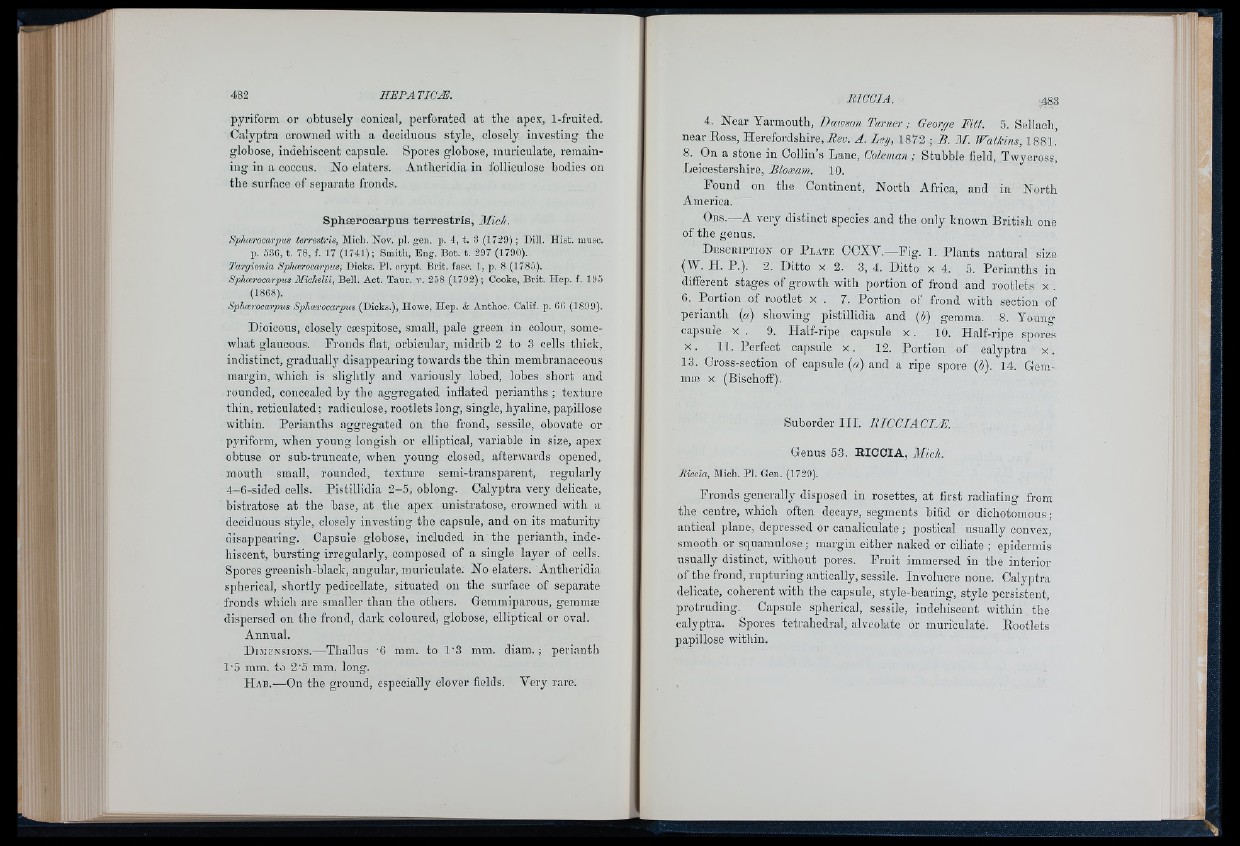
ilb
pyriform or obtusely conical, perforated at the apex, 1-frulted.
Calyptra crowned with a deciduous style, closely investing the
globose, indéhiscent capsule. Spores globose, muriculate, remaining
in a coccus. No elaters. Antheridia in folliculose bodies on
the surface of separate fronds.
Sphærocarpus te rre s tris, Ilich.
Sphcerocarpus terrestris, Mich. Nov. pi. gen. p. 4, t. 3 (1729) ; Dill. Hist. nmsc.
p. 53C, t. 78, f. 17 (1741); Smith, Eng. Bot. t. 297 (1790).
Targionia Sphærocarpus, Dicks. PI. crypt. Brit. fasc. 1, p. 8 (1785).
Sphærocarpus Miehelii, Bell. Act. Taur. v. 258 (1792); Cooke, Brit. Hep. f. 195
(18C8).
Sphcerocarpus Sphairocarpus (Dicks.), Howe, Hep. & Anthoc. Calif, p. GG (1899).
Dioicous, closely cæspitose, small, pale green in colour, somewhat
glaucous. Fronds flat, orbicular, midrib 2 to 3 cells thick,
indistinct, gradually disappearing towards the thin membranaceous
margin, which is slightly and variously lobed, lobes short and
rounded, concealed by the aggregated inflated perianths ; texture
thin, reticulated ; radiculose, rootlets long, single, hyaline, papillose
within. Perianths aggregated on the frond, sessile, obovate or
pyriform, when young longish or elliptical, variable in size, apex
obtu.se or sub-truncate, when young closed, afterwards opened,
mouth small, rounded, texture semi-transparent, regularly
4-6-sided cells. Pistillidia 2-5, oblong. Calyptra very delicate,
bistratose at the base, at the apex unistratose, crowned with a
deciduous style, closely investing the capsule, and on its maturity
disappearing. Capsule globose, included in tlie perianth, indéhiscent,
bursting irregularly, composed of a single layer of cells.
Spores greenish-black, angular, muriculate. No elaters. Antheridia
spherical, shortly pedicellate, situated on the surface of separate
fronds which are smaller than the others. Gemmiparous, gemmæ
dispersed on the frond, dark coloured, globose, elliptical or oval.
Annual.
D im t n s io n s .— Thallus '6 mm. to 1'3 mm. diam.; perianth
1'5 mm. to 2’5 mm. long.
H ab.— On the ground, especially clover fields. Very rare.
4. Near Yarmouth, Dawson Turner ; George Fitt. 5. Sellach,
near Ross, Herefordshire, A. Leg, 1872 ; H. M. Watkins, 1881.’
8. On a stone in Collin’s Lane, Coleman; Stubble field, Tvvycross,
Leicestershire, Bloxam. 10.
Pound on the Continent, North Africa, and in North
America.
O b s .—A very distinct species and the only known British one
of the genus.
D e s c r i p t i o n or P l a t e CCXV.—Pig. 1. Plants natural size
(W. H. P.). 2, Ditto X 2. 3, 4. Ditto x 4. 5. Perianths in
different stages of growth with portion of frond and rootlets x .
6. Portion of rootlet x . 7. Portion of frond with section of
perianth {a) showing pistillidia and {h) gemma. 8. Young
capsule x . 9. Half-ripe capsule x . 10. Half-ripe spore’s
X . IT. Perfect capsule x . 12. Portion of calyptra x .
13. Gross-seotion of capsule {a) and a ripe spore (/;). 14. Gemma;
X (Bischoff).
Suborder H I. EICCIACDE.
Genus 53. RICCIA, Mich.
Miccia, Mich. PI. Gen. (1729).
Fronds generally disposed in rosettes, at first radiating from
the centre, vvhich often decays, segments bifid or dichotomous;
antical plane, depressed or canaliculate ; postical usually convex,
smooth or squamulose ; margin either naked or ciliate ; epidermis
usually distinct, without pores. Fruit immersed in the interior
of the frond, rupturing antioally, sessile. Involucre none. Calyptra
delicate, coherent with the capsule, style-bearing, style persistent,
protruding. Capsule spherical, sessile, indéhiscent within the
calyptra. Spores tetrahedral, alveolate or muriculate. Eootlets
papillose within.